Elevate your garden’s potential with our DIY Elevated Garden Bed Plans, perfect for those aiming to enhance their gardening experience. Our collection of 15 free DIY elevated garden bed plans makes building a raised garden bed an accessible project for all, ensuring a comfortable height for maintenance and effective pest control. With these plans, moderate soil and water drainage effortlessly, creating the ideal conditions for your plants to thrive.
Dive into our guide and discover the simplicity of crafting your own elevated garden bed. Step-by-step instructions, coupled with expert tips, will guide you through the process. These beds aren’t just practical; they add a touch of beauty to any outdoor space. Get ready to enjoy the benefits of elevated gardening, and keep reading for a fulfilling building DIY elevated garden bed that awaits you.
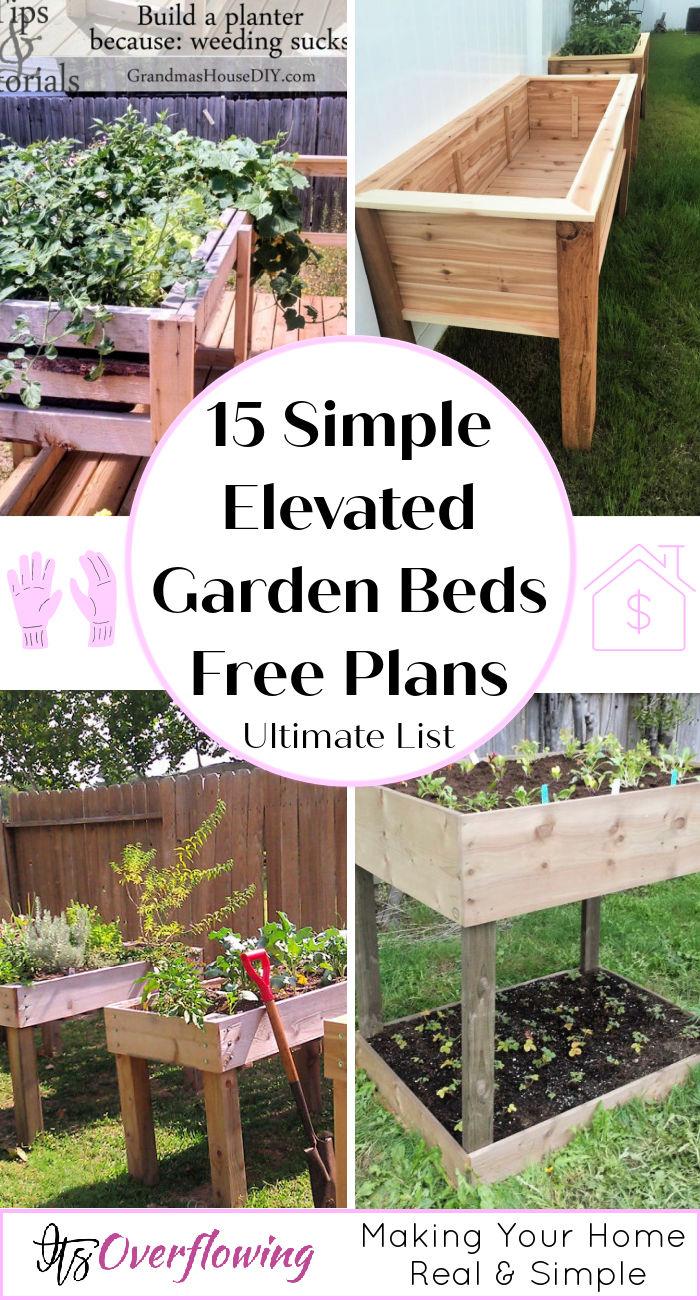
Why Build an Elevated Garden Bed?
Discover the benefits of elevated garden beds for easier maintenance, improved soil conditions, and higher yields—a key to successful urban gardening.
- Easier Maintenance: Elevated garden beds bring the garden to a comfortable height, making it easier to tend to your plants. This reduces the need for bending and stooping, saving your back and knees from strain.
- Improved Pest Control: Raising your garden off the ground can help protect it from various pests like slugs and snails. It can also discourage pets and wildlife from trampling your plants or using the garden as a litter box.
- Enhanced Soil Conditions: Elevated garden beds allow you to create the perfect soil mixture for your plants, independent of the ground conditions. This means better drainage, soil aeration, and an ideal environment for root growth.
- Extended Growing Season: Soil in raised beds warms up more quickly in spring compared to ground soil. This can give you a head start on the growing season and potentially allow you to keep plants longer into the fall.
- Aesthetic Appeal: Elevated garden beds can add structure and beauty to your outdoor space. They offer a neat, contained area for your plants, which can be both functional and decorative.
- Accessibility: For those with mobility issues or gardeners who prefer not to kneel or sit on the ground, an elevated bed makes gardening accessible and enjoyable for everyone.
By incorporating an elevated garden bed into your outdoor space, you’re investing in the health of your garden, the ease of your gardening experience, and the beauty of your landscape. Whether you’re an experienced gardener or just starting out, elevated garden beds can provide numerous benefits that enhance your connection with nature.
How to Build Your Own DIY Elevated Garden Bed
Building a DIY elevated garden bed can enhance your gardening experience by reducing the need to bend over and improving your control over soil conditions. Here’s a step-by-step guide to help you build one easily.
Step 1: Gather Your Materials and Tools
Start by collecting all the necessary materials. You’ll typically need:
- Wood slats (like cedar, pine, or reclaimed pallet wood)
- 4×4 posts for the legs
- Wood screws or nails
- Landscaping fabric
- Soil and compost
For tools, make sure you have:
- A saw (hand saw or power saw)
- Drill or hammer
- Screwdriver or nail gun
- Staple gun
- Measuring tape
- Level
Step 2: Design Your Elevated Garden Bed
Decide on the size and height of your garden bed. A standard size is 4 feet by 8 feet, but you can adjust this based on your space and needs. Remember that a height of around 30 inches is typically comfortable for most people to work with.
Step 3: Cut Your Wood to Size
Measure and cut your wood slats to create the sides of your garden bed. If you’re making a 4×8 bed, you’ll need four 8-foot-long pieces for the long sides and four 4-foot-long pieces for the short sides. Cut the 4×4 posts to your desired height for the legs.
Step 4: Assemble the Bed Frame
- Attach the long and short sides together to form a rectangle using screws or nails. Ensure the corners are square by measuring diagonally across the rectangle.
- Secure the 4×4 posts at each corner, drilling from the outside of the bed into the end grain of the post to give the bed legs and elevate it.
Step 5: Add Support and Drainage
- For larger beds, add additional 4×4 posts along the long sides for support.
- Cover the bottom with landscaping fabric to prevent soil from falling through while allowing water to drain. Staple the fabric to the bottom edges of the bed.
Step 6: Position and Level Your Garden Bed
Choose a location for your garden bed and place it there. Use a level to ensure that the bed is even on all sides. Adjust the legs as necessary by digging into the ground or adding soil underneath.
Step 7: Fill with Soil
Mix soil and compost and fill your elevated garden bed. The soil should be rich and well-draining to provide optimal conditions for plant growth.
Step 8: Plant Your Seeds or Seedlings
Once your bed is filled with soil, it’s time to plant. Follow the spacing guidelines for whatever plants you’ve chosen. Water the plants thoroughly after planting.
Step 9: Maintain Your Elevated Garden Bed
Regularly check on your plants, water as needed, and enjoy the process of growing your own vegetables, herbs, or flowers without the back strain of traditional gardening.
Helpful Tips:
- For longevity, consider using rot-resistant wood like cedar.
- If mobility is an issue, ensure the pathways around the bed are wide enough for easy access.
- Incorporate a drip irrigation system for easier watering.
- To further deter pests, consider adding a removable netting or fencing around the bed.
Building an elevated garden bed can be a satisfying DIY project that not only makes gardening easier on your back but also adds beauty and structure to your outdoor space. With these steps, you’ll be well on your way to enjoying your very own elevated garden.
Frequently Asked Questions About DIY Elevated Garden Bed Plans
Discover expert tips and plans for your DIY elevated garden bed project in our comprehensive FAQ guide – your essential resource for a thriving garden!
What are the benefits of an elevated garden bed?
Elevated garden beds offer several advantages:
- They reduce back and knee strain by minimizing bending and stooping.
- They improve pest control, deterring slugs, snails, and other garden pests.
- They allow for better soil condition management, including drainage and aeration.
- They can extend the growing season since the soil warms up faster.
- They add aesthetic appeal to your garden.
- They are more accessible for individuals with mobility issues.
How do I choose the right materials for my elevated garden bed?
When selecting materials for your elevated garden bed, consider:
- Durability: Opt for rot-resistant woods like cedar or redwood.
- Cost: Pressure-treated lumber is more affordable but ensure it’s safe for growing edibles.
- Eco-friendliness: Reclaimed wood or pallets can be a sustainable choice.
- Maintenance: Some materials require more upkeep, so choose according to your willingness to maintain.
What tools will I need to build an elevated garden bed?
Typically, you’ll need the following tools:
- A saw for cutting wood (hand saw or power saw)
- A drill or hammer for assembly
- A screwdriver or nail gun for securing components
- A staple gun for attaching landscaping fabric
- A measuring tape to ensure accurate dimensions
- A level to ensure the bed is even
Can I build an elevated garden bed on a balcony or small patio?
Yes, you can build a smaller-scale elevated garden bed suitable for a balcony or patio. Make sure to measure your space and design the bed accordingly, and ensure the structure can support the weight of the soil when saturated.
How do I protect my elevated garden bed from pests?
To protect your garden bed from pests:
- Physical barriers: Add a wire mesh bottom or line with hardware cloth to prevent burrowing pests.
- Natural repellents: Plant companion plants that naturally deter pests.
- Maintenance: Regularly inspect your plants and remove any pests by hand if necessary.
- Enclosures: Consider adding netting or a frame with insect-proof mesh to cover the bed.
What is the best soil mix for an elevated garden bed?
A well-draining soil mix is crucial. A popular mix for elevated beds is the “Mel’s Mix” from the Square Foot Gardening method, which consists of:
- 1/3 peat moss or coconut coir for moisture retention
- 1/3 vermiculite or perlite for aeration
- 1/3 compost for nutrients
How do I ensure proper water drainage in my elevated garden bed?
To ensure proper drainage:
- Use landscaping fabric: This allows water to drain through while holding the soil.
- Drainage holes: If your bed has a solid bottom, drill holes for excess water to escape.
- Layer materials: Start with a layer of gravel or broken pots before adding your soil mix.
Can I make my elevated garden bed self-watering?
Yes, you can incorporate a self-watering system into your design. This usually involves a water reservoir beneath the soil and a wicking system to draw water up as the plants need it. Look for specific DIY self-watering bed plans for detailed instructions.
How often should I water my elevated garden bed?
Watering frequency depends on several factors, including the weather, the type of plants, and the soil mix. As a general rule, water when the top inch of the soil feels dry to the touch. Elevated beds may require more frequent watering since they drain faster.
What should I do to maintain my elevated garden bed over time?
To maintain your elevated garden bed:
- Inspect regularly: Check for signs of wear, loose screws, or rot and make repairs as needed.
- Refresh soil annually: Top up with compost to replenish nutrients.
- Clean between seasons: Remove old plants and debris to prevent disease and pests.
- Stain or seal wood: If you use a wood like pine, consider staining or sealing it every few years to extend its life.
Remember to tailor your gardening practices to your specific environment and plant choices, and enjoy the process of creating and nurturing your elevated garden bed!
15 Free DIY Elevated Garden Bed Plans
Build your dream garden with ease using our 15 free DIY elevated garden bed plans – perfect for any space and skill level!
1. How to Build an Elevated Garden Bed
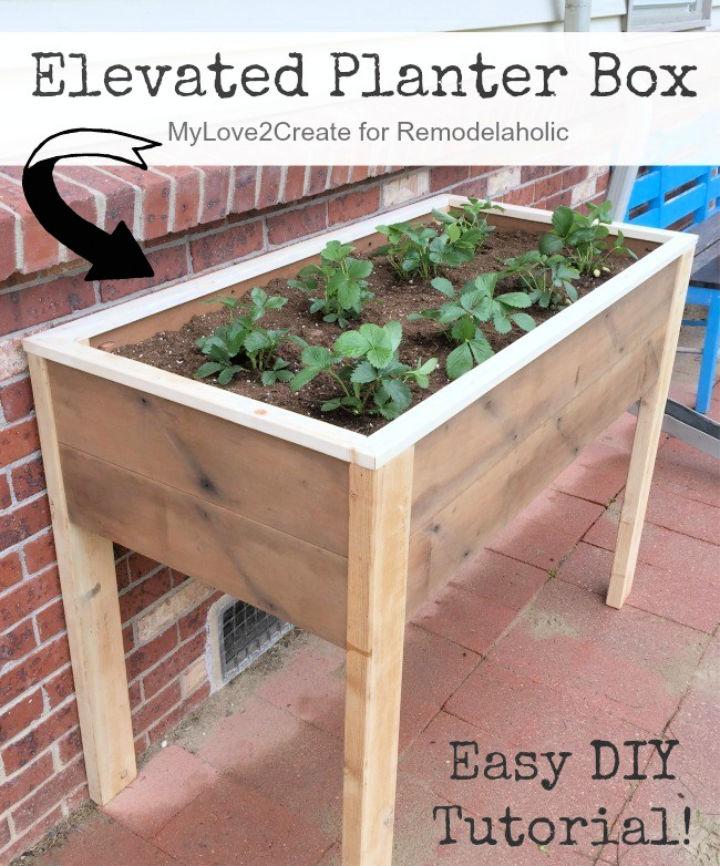
Get ready to elevate your gardening game with Remodelaholic‘s DIY elevated planter box guide! Ideal for those who want to grow their own fresh foods without the strain on their back and knees, this step-by-step tutorial will help you craft a sturdy and simple raised garden bed.
With clear instructions and a cut list, you’ll learn how to construct a planter that stands 35.75 inches tall and spans 48 inches by 24 inches. Perfect for a variety of plants, from strawberries to herbs and veggies, this planter is not only functional but can also be a charming addition to your outdoor space. Grab your tools, and let’s build a garden that’s both accessible and enjoyable!
2. DIY Wooden Elevated Garden Bed
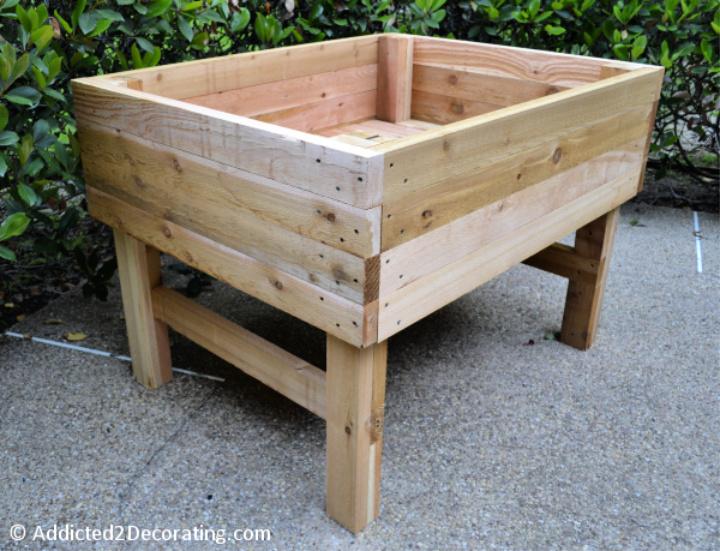
Learn how to build an elevated garden with this easy-to-follow guide from Addicted 2 Decorating. Perfect for small outdoor spaces like balconies or patios, this DIY project allows you to grow fresh organic vegetables right outside your door. Kristi Linauer walks you through the process with clear instructions and a list of materials and tools needed. Create your own raised garden table to enjoy homegrown produce even with limited space. Get started on your elevated garden bed and savor the taste of your own harvest! Choose the cedar boards for this elevated planter box.
3. Homemade Elevated Raised Garden Bed
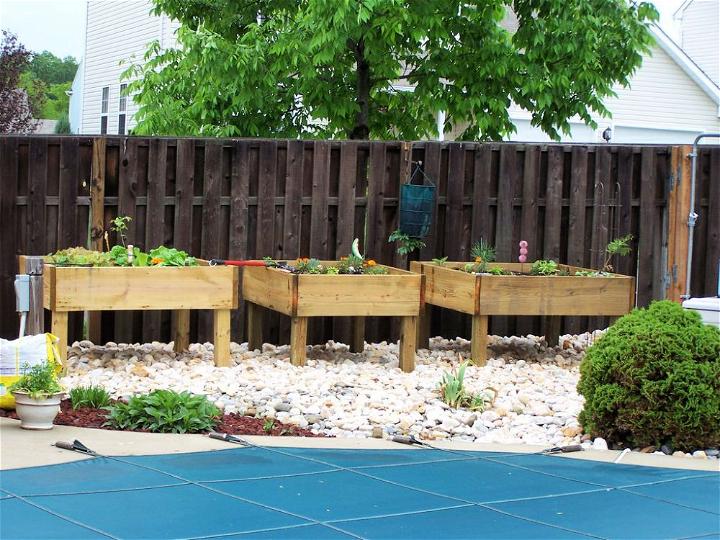
Instructables offers a step-by-step guide on crafting a raised garden bed on legs, a perfect project for those aiming to garden comfortably without the strain of bending over. Ideal for keeping pets away from your plants, this DIY solution combines practicality with ease of access. Learn how to build a durable, elevated garden bed that can fit in various outdoor spaces and enhance your gardening experience. With clear instructions and helpful tips, you’ll be able to create a functional and attractive raised bed that suits your needs and skill level.
4. Free Elevated Garden Bed Woodworking Plan
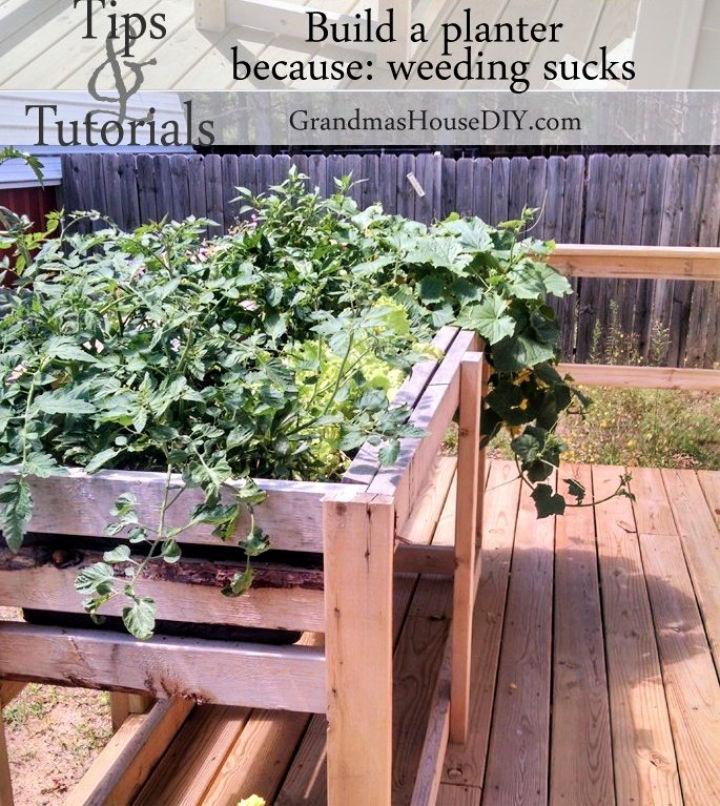
Tired of the endless battle with weeds in your garden? Grandmas House DIY has a solution: a DIY tall garden planter that simplifies your gardening experience. Constructed from sturdy 2x4s and durable steel, this planter raises your gardening space to a comfortable height, minimizing back strain and weeding time.
The design ensures ample depth for a variety of plants, from onions to flowers, and includes efficient drainage to keep your soil healthy. Follow this engaging guide to create a practical and attractive addition to your deck or backyard, perfect for gardeners seeking an easier way to enjoy their passion.
5. DIY Self-Watering Veggie Elevated Garden Bed
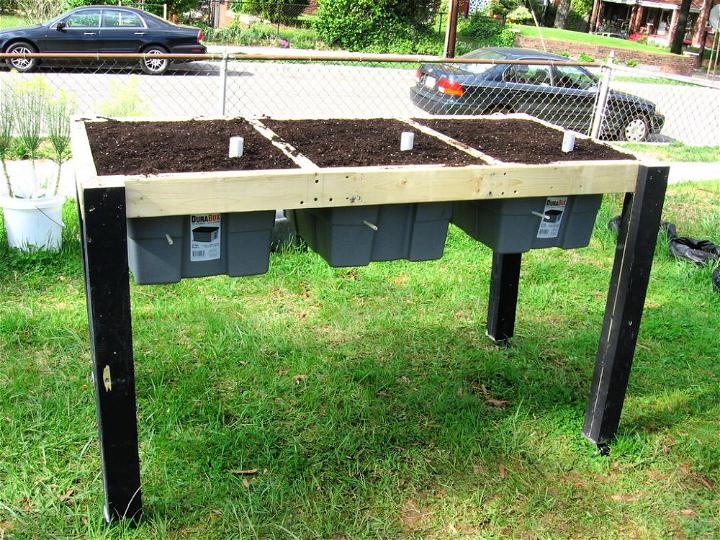
Discover a practical guide to building a self-watering veggie table on Instructables that can transform your gardening experience. Ideal for those who want to avoid the hassle of daily watering, this DIY project allows plants to absorb moisture as needed, promoting healthy growth. With clear instructions, material lists, and step-by-step images, creating a sustainable garden space is made accessible. This self-watering system is perfect for urban gardeners or anyone with limited space, looking to cultivate their greens efficiently. Get ready to grow your veggies with ease and confidence.
6. Build Your Own Raised Garden Bed
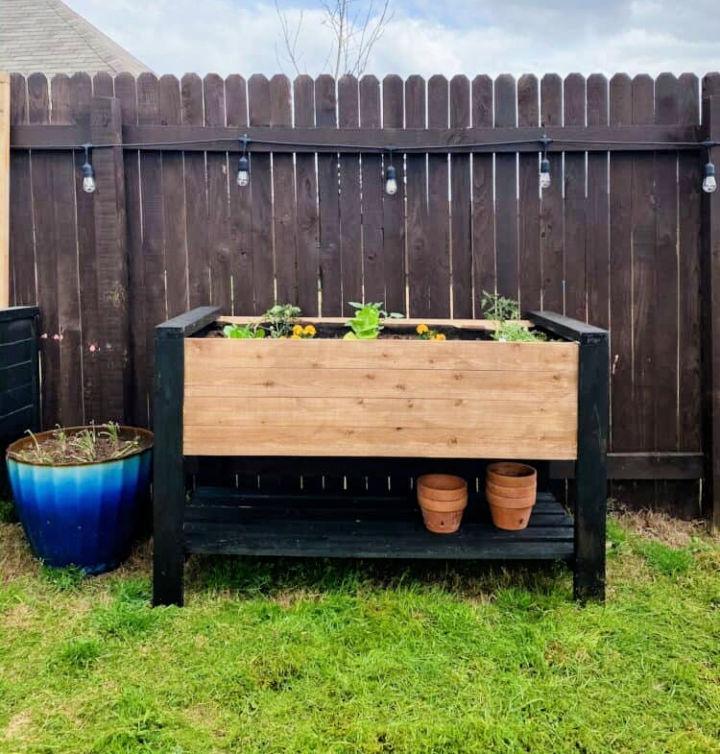
Building a DIY raised garden bed is a smart solution for gardening enthusiasts facing challenges like limited space, uneven terrain, or poor soil quality. Love & Renovations provides a comprehensive guide on building a raised garden bed that stands on legs, enhancing weed prevention and ease of access.
The guide details the materials and tools needed, such as cedar boards, chicken wire, and landscaping fabric, and offers a step-by-step process, from cutting wood to adding finishing touches like a trellis or stain. With practical tips on wood choices and the importance of proper support, the guide ensures your garden bed is both beautiful and durable. Get ready to grow a variety of plants, from tomatoes to herbs, and enjoy the rewards of a flourishing garden.
7. How to Make a Pallet Wood Elevated Garden Bed
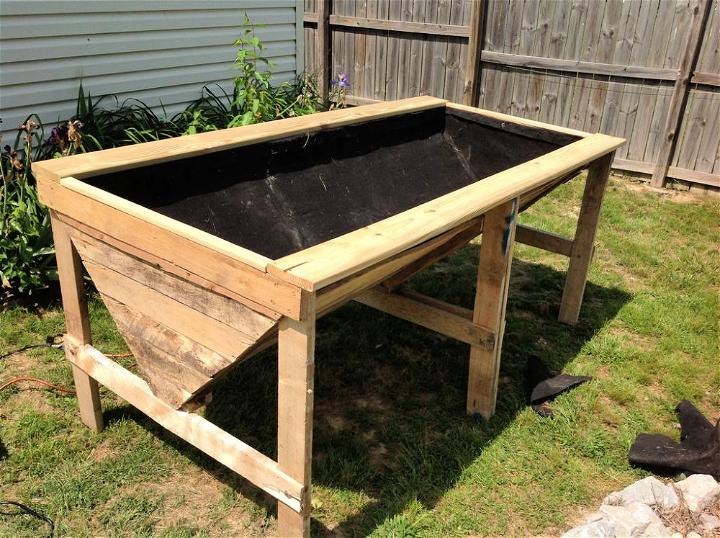
If you’re keen on gardening but want to keep pests at bay, constructing a raised planter bed from pallets is an excellent DIY project. Instructables offers a step-by-step guide on how to create a durable and cost-effective garden bed using repurposed pallets. Ideal for those who enjoy upcycling, this guide provides clear instructions and tips to help you build a planter that not only enhances your garden’s aesthetics but also promotes better plant health.
It’s a practical way to grow your favorite herbs, flowers, or vegetables while minimizing the hassle of bending down or dealing with soil-borne critters. Get ready to elevate your gardening game with this eco-friendly and satisfying project!
8. Handmade Raised Herb Garden Planter
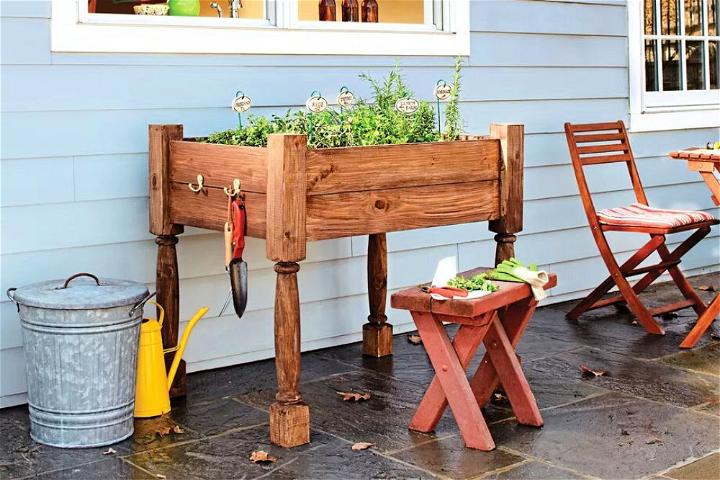
Building a raised herb garden planter is a simple and rewarding DIY project, ideal for those with limited yard space or a desire for a convenient kitchen garden. This Old House provides a step-by-step guide to constructing a compact, all-weather planter using basic carpentry tools and materials.
Perfect for porches or patios, the design includes a durable liner and floorboards for soil support, ensuring your herbs thrive. With added hooks for tools, this garden bed is not only functional but also enhances your outdoor living space. Follow these instructions to grow fresh herbs effortlessly right outside your door.
9. DIY Wood Elevated Garden Bed for Kids
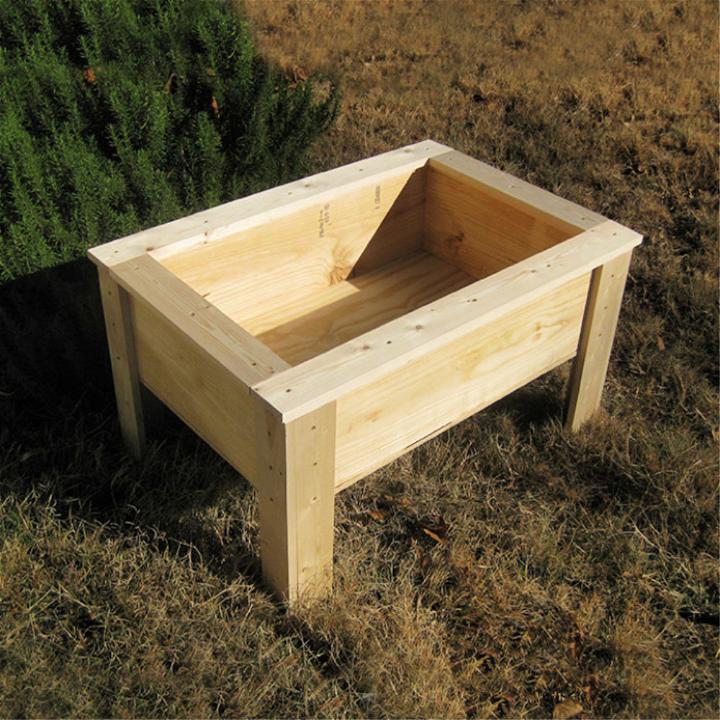
Introducing kids to the joys of gardening can be both educational and fun, and FineGardening provides an excellent guide to building a DIY starter raised bed that’s perfect for young green thumbs. This easy-to-follow tutorial walks you through creating a small, child-friendly 2×3 foot raised bed. With simple materials like wood boards, screws, and basic tools, you can construct a sturdy and movable garden bed, ideal for planting a variety of veggies.
Customizable in height to suit your child’s needs, this project is not only a great way to spend quality time together but also a fantastic learning opportunity for kids to witness the growth cycle of plants. Get ready to nurture their interest in horticulture with this engaging and practical outdoor activity.
10. Building Counter Height Garden Boxes
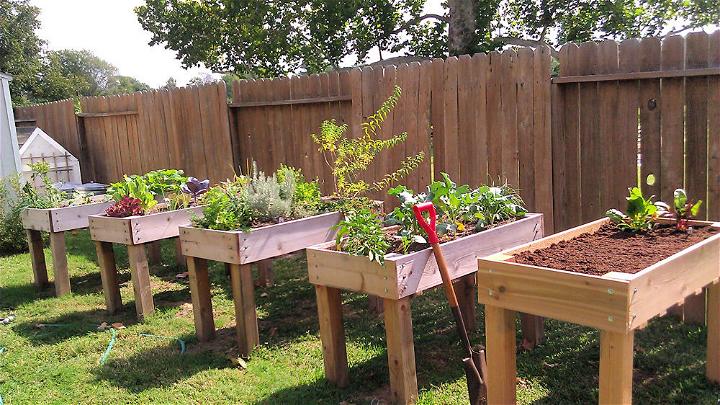
Discover how to construct simple raised garden boxes with guidance from Janet Fox. These beginner-friendly projects are perfect for gardeners who find it challenging to work at ground level due to mobility issues or discomfort. Janet shares her personal experience and offers an accessible pattern, which she has successfully used to create six of her own garden boxes.
With detailed instructions, including a shopping list, cut list, and step-by-step assembly advice, you can build your own counter-height garden boxes. These structures are not only practical but also avoid the use of treated lumber, ensuring a healthy environment for your vegetables to thrive. Visit Ana White for the complete tutorial and start enjoying the benefits of raised bed gardening today.
11. Free Wooden Elevated Planter Raised Bed Plan
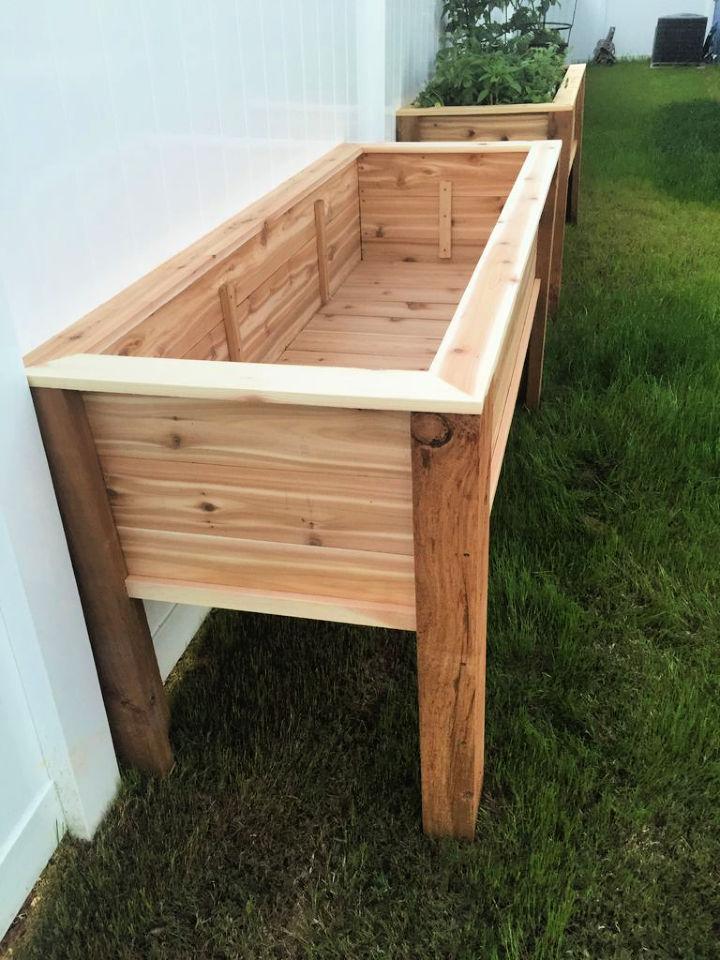
For those keen on gardening, the Elevated Planter Raised Bed guide on Instructables offers a comprehensive step-by-step process to build your own. Ideal for small spaces or to avoid the strain of bending over, this raised bed planter elevates your gardening experience. The tutorial is thorough and designed to be accessible, ensuring that you can create a functional and attractive raised bed that suits your needs. With detailed instructions and a list of materials, you’ll be well-equipped to enhance your outdoor space and enjoy the benefits of elevated gardening.
12. Make a Standing Raised Garden Bed
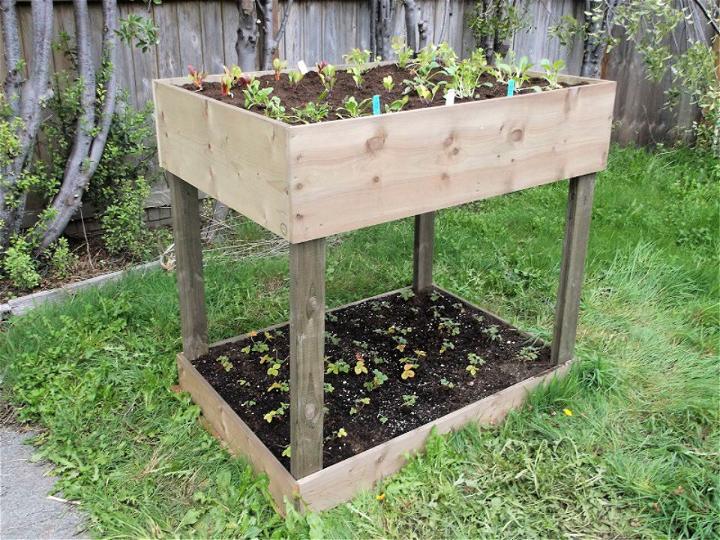
Making a standing raised garden bed is a clever way to cultivate your green space without the strain of bending or kneeling. Mike’s Backyard Nursery offers a comprehensive guide that simplifies the process into manageable steps, making it accessible for all garden enthusiasts.
With detailed instructions on constructing a dual-purpose garden bed, this resource also highlights the water conservation benefits of this design, ideal for drought-prone areas. The guide is complete with a list of necessary tools, materials, and construction techniques, ensuring a successful project that enhances both your gardening experience and your outdoor living space.
13. DIY Wooden Raised Garden Bed With Legs
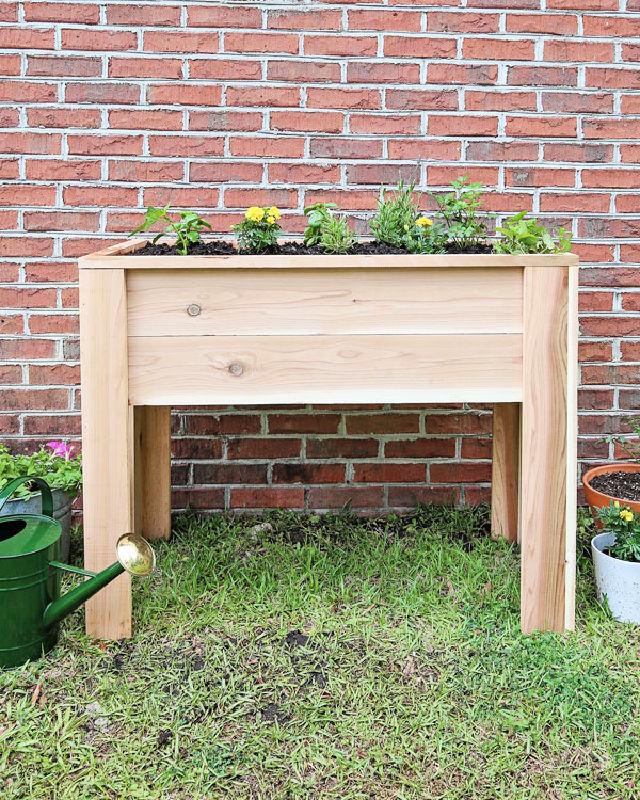
Elevate your gardening game with Angela Marie Made‘s guide on constructing a raised garden bed with legs. This cedar DIY project is perfect for adding greenery to small spaces or patios, offering an accessible planting experience without the need to bend over. With detailed instructions, material lists, and a step-by-step video, building your own garden bed becomes an achievable weekend activity.
Discover how to use cedar for its natural weather resistance and get tips on the best soil for raised beds. Fill your new garden with herbs, flowers, or vegetables and enjoy the convenience and beauty it brings to your outdoor area. Visit Angela Marie Made for the full tutorial and get started on your gardening project today.
14. How to Build a Tiered Raised Garden Bed
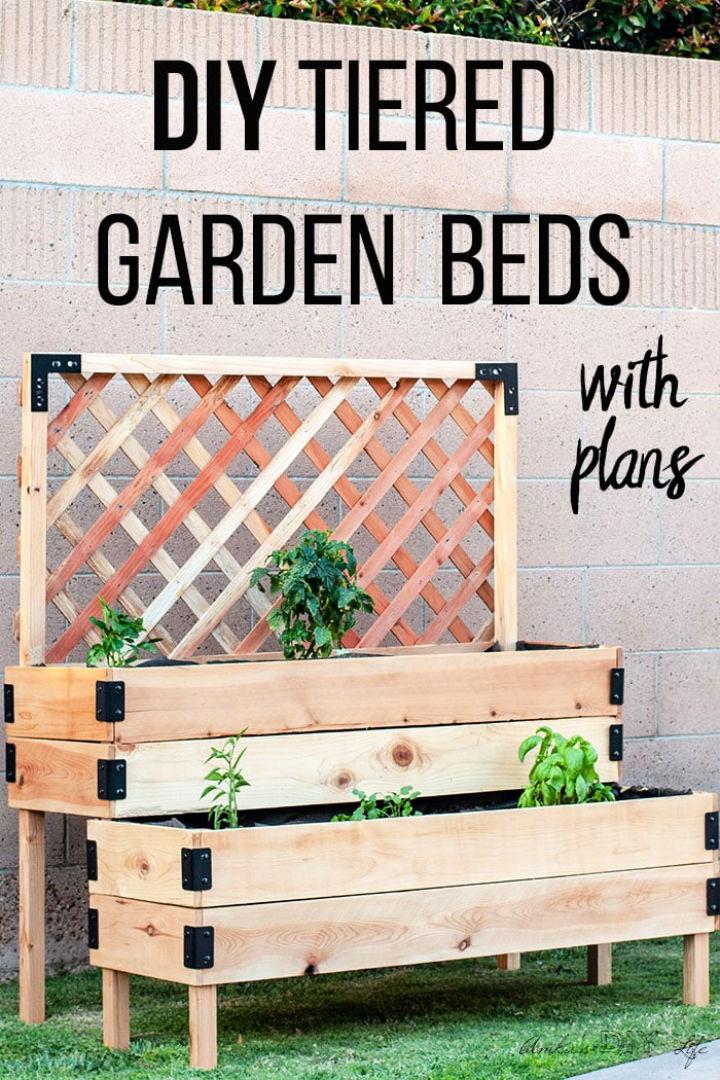
Discover how to create a DIY tiered raised garden bed with Anika Gandhi’s step-by-step guide on Anika’s DIY Life. Perfect for small outdoor spaces like patios and decks, this project utilizes cedar fences and 2x4s to craft a functional and stylish garden area for your herbs, vegetables, or flowers.
The tutorial is comprehensive and includes printable build plans, making it accessible for anyone looking to add a touch of greenery to their home. With helpful tips and a list of materials and tools, you’ll be ready to construct a garden bed that not only serves as a home for your plants but also enhances the beauty of your backyard.
15. Cheap DIY Waist High Raised Garden Bed
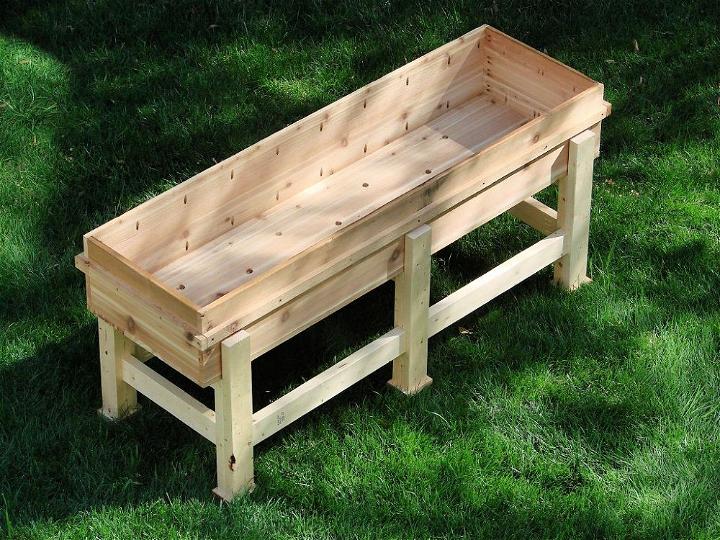
Building a waist-high planter box can transform your gardening experience, offering comfort and convenience while cultivating your favorite vegetables, herbs, or flowers. Instructables provides a comprehensive guide on building a sturdy and enduring planter box that stands at a comfortable height, eliminating the need to bend or kneel.
This type of planter is ideal for those with limited mobility or who simply wish to enhance the aesthetic of their outdoor space. With clear, step-by-step instructions, you’ll learn how to construct a planter that’s not only functional but also adds a touch of self-sufficiency to your home by bringing you closer to vegetable independence.
Conclusion:
In conclusion, our collection of “15 Free DIY Elevated Garden Bed Plans” offers an excellent opportunity to enhance your gardening experience. By raising your garden bed, you can enjoy the numerous benefits of an elevated approach, such as improved soil conditions, better pest control, and a more comfortable gardening experience. With step-by-step instructions and expert tips included in our guide, building your own raised garden bed becomes a manageable and rewarding project. Get ready to transform your outdoor space into a thriving haven for your plants. Happy gardening!
- Garden Tool Storage: Easy access to essential tools makes gardening more of a pleasure than a chore. Check these Garden Tool Storage Ideas.
- Woodworking: Make confidence with DIY project ideas by following these free woodworking plans.
